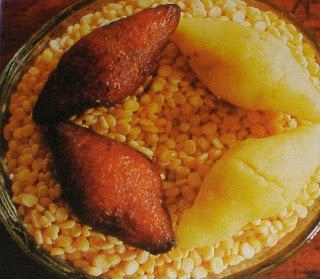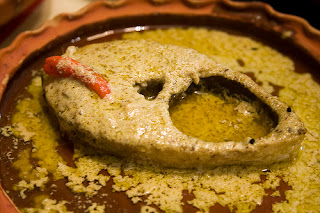Today, while I conclude my short and summarized episode of Bongelicious,I am much eager to post about the sweets of Bengal. For Bengalis, sweets stand tall in their priority list as they form an important aspect in their day-to-day lives. A common Bengali adage refers to thirteen festivals in twelve months. Festive rituals abound throughout the year and sometimes vary from family to family and no festive or holy occasion is complete without the myriad of sweet delicacies. The king of all sweets is the Rasgulla or the "roshogolla" as it is called in Bengal. The very popular nutritious syrupy-sweet dish made from Indian cottage cheese or "chhana" is loved by all. Roshogolla is a Bengalis most famous culinary weapon. It is well reputed all over India and certain parts of South Asia. Owing to its popularity, nowadays canned rasgullas are sold in some confectionery stores.
In both Bangladesh and West Bengal the tradition of making different kinds of pan-fried steamed or boiled sweets,lovingly known as"pithe" or "pitha" still flourishes. These little balls of heaven symbolises the coming of winter. The richness lie in the creamy silkiness which is mixed with molasses or jaggery,made of either sugarcane or date-palm,and sometimes sugar. In both rural and urban areas of West Bengal almost every house holds the very famous pitha and "pati-shapta" festival during the winter. The celebration of Pitha as a traditional sweet is the time for the winter harvest festival or "Nobanno". The entire culture of making these sweets at home during harvest and offering it to friends and neighbours is to induce wellness and deriving blessings through their hard work.
Tomato-r chutney,"Khejur-Aamshottor chutney","Aanarosher chutney","Aamer chutney" are some of the must-haves of a Bengali menu.Several varities of yoghurt,such as "mishti doi",custard and rice-pudding are also popular in Bengal. Sandesh, Rosomalai, Chhanar jeelipi, Darbesh, Raghobshai, Payesh, Bundiya, Nalengur, Lagcha and many more sweet delicacies are always available in the thousands of sweet shops or "mishtir dokan" in every lane and streets of Kolkata and outskirts.Example of some nation-wide famous sweet shops of Kolkata are K.C Dass,Bhim Nag,Girish & Nakur,Senmahasay,Ganguram's,Balaram Mullick & Radharaman Mullick,Banchharam,Mouchak,Deshbandhu.
Trust me,all you have to do is to loose your bucks at different sweet shops of Kolkata and you are going to thank me each time you savour those delicacies.
Hereby I enclose some videos and links for further detailed information.
http://www.tarladalal.com/recipes-for-bengali-sweets-67
http://indianfood.about.com/od/sweetsanddesserts/tp/topbengalsweets.htm
http://allrecipes.co.in/recipes/sweets-recipes.aspx



















